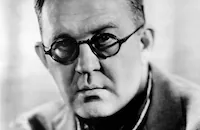Young Cassidy

Brief Synopsis
Cast & Crew
Jack Cardiff
Rod Taylor
Flora Robson
Jack Macgowran
Sian Phillips
T. P. Mckenna
Film Details
Technical Specs

Synopsis
In Dublin in 1911 during a period of growing protest against British rule, young John Cassidy is a laborer by day and a pamphleteer by night. Cassidy is a member of both the Irish Transport and General Workers Union and the Irish Citizens Army, which is trained for uprisings against the British. When the pamphlets he has written incite riots, Cassidy realizes that he can do more for his people with the pen than with the sword. In the course of a riot, Cassidy rescues Daisy Battles, a fiery music hall dancer, and they soon become lovers. Their affair is short-lived, however, and Cassidy becomes involved with Nora, a bookshop clerk who encourages his writing and falls in love with him. He brings a play he has written to the Abbey Theatre; and though it is rejected, another of his plays, The Shadow of a Gunman , is accepted and successfully produced, as are two subsequent plays. The opening of The Plough and The Stars , which deals with religion, sex, and patriotism in Ireland, causes the audience to riot, and he loses many friends; but he is undeterred and is soon acclaimed as Ireland's outstanding young playwright. Nora realizes that Cassidy no longer needs her, and he departs for England and international acclaim.

Cast

Rod Taylor

Flora Robson

Jack Macgowran

Sian Phillips
T. P. Mckenna
Julie Ross
Robin Sumner
Philip O'flynn

Maggie Smith

Julie Christie
Pauline Delany

Edith Evans

Michael Redgrave
Arthur O'sullivan
Joe Lynch
Vincent Dowling
Tom Irwin
John Cowley
Bill Foley
John Franklin
Harry Brogan
Anne Dalton
Donal Donnelly
Martin Crosbie
Fred Johnson
Eddie Golden
Chris Curran
James Fitzgerald
Shivaun O'casey
Harold Goldblatt
Ronald Ibbs
May Craig
May Cluskey
Members Of The Abbey Theatre Company
Crew
Robert Allen
Jack Atchelor
Maurice Binder
Miriam Brickman
Anne V. Coates
Phyllis Crocker
Marcus Dods
John Ford
Margaret Furse
Ernest Gasser
Robert Emmett Ginna
Robert D. Graff
Teddy Joseph
Michael Killanin
Sean O'riada
Maud Onslow
John Quested
Winston Ryder
Ted Scaife
Michael Stringer
John Whiting

Videos
Movie Clip



Trailer
Hosted Intro


Promo
Film Details
Technical Specs

Articles
Young Cassidy
By the time filming was set to begin on O'Casey's 1956 autobiography, however, he had apparently changed his opinion somewhat, giving his okay to the script of Young Cassidy (1965) shortly before he died. The film covers about a dozen years in O'Casey's (called "John Cassidy" in the film) young life, from 1911, when the Irish were staunchly protesting British rule, to his move to England in the 1920s after his play "The Plough and the Stars" caused riots and lost him many supporters. The rebellious and uncertain atmosphere of the times, with the Citizens Army confronting the British in the streets and intellectuals like O'Casey doing battle with their pens , is captured on location in Dublin by director Jack Cardiff, but the picture has always been billed as "A John Ford Film."
After completing Cheyenne Autumn (1964), the great director jumped at the chance to film O'Casey's story, offering to take the job for a mere $50,000. But only a few weeks into filming, he became ill, and the producers were forced to replace him with Cardiff, a noted cinematographer who had worked successfully with filmmaker Michael Powell on the British classics Black Narcissus (1947) and The Red Shoes (1948). Ford's contributions to Young Cassidy total only about 10 minutes of screen time, although those are some of the most tender and fully realized, especially the scenes he shot between Rod Taylor as Cassidy and Julie Christie as his first love. Ford made only one more film, Seven Women (1966) before his death in 1973.
Australian-born Taylor was highly praised for his work in Young Cassidy, which several critics considered his finest role. But the film is also notable for sterling supporting players, not only early screen appearances of future stars Christie and Maggie Smith, but also the performances of several of the most respected veterans of British stage and screen. At this point in their long careers, all of them had been given the title "knight" or "dame" in recognition of their professional achievements. Dame Flora Robson portrayed Cassidy's understanding mother; later in the film, he becomes the protege of the kindly Lady Gregory (Dame Edith Evans) and the famed poet William Butler Yeats (Sir Michael Redgrave). Although all three had long and successful stage careers, they also logged in combined screen time of more than 150 years (Evans, in fact, made her first picture in 1915). Not limited to British productions, their work also included a number of American films, and all three were Oscar nominated: Robson for Saratoga Trunk (1946), Redgrave for Mourning Becomes Electra (1947) and Evans for The Whisperers (1966).
Director: Jack Cardiff, John Ford (uncredited)
Producers: Robert Emmett Ginna, Robert D. Graff, Michael Killanin
Screenplay: John Whiting
Cinematography: Edward Scaife
Art Direction: Michael Stringer III
Music: Sean O'Riada
Cast: Rod Taylor (John Cassidy), Flora Robson (Mrs. Cassidy), Maggie Smith (Nora), Julie Christie (Daisy Battles), Edith Evans (Lady Gregory), Michael Redgrave (W.B. Yeats).
C-111m.
by Rob Nixon

Young Cassidy
Quotes
Trivia
Director 'Ford, John' fell ill during production and was replaced by Jack Cardiff.
Notes
Filmed on location in and around Dublin. Opened in London in February 1965; running time: 110 min. Original director John Ford was replaced by Jack Cardiff, who receives screen credit.

Miscellaneous Notes
Released in United States Spring March 1965
John Ford was taken off the picture after thirteen days on account of illness prompted by heavy drinking. He was replaced by Cardiff. Ironically, Ford wanted to direct the picture so badly that he only took a $50,000 fee.
Released in United States Spring March 1965

















